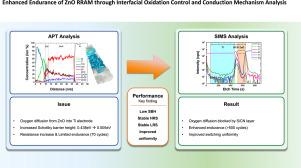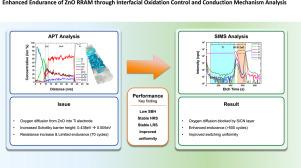界面氧化控制对ZnO RRAM续航性能的影响及导电机理分析
IF 6.9
2区 材料科学
Q2 CHEMISTRY, PHYSICAL
引用次数: 0
摘要
在本研究中,研究了Ti电极的ZnO RRAM的可靠性,重点研究了Ti - ZnO界面上氧化钛(TiOX)的形成。电气测量,包括直流扫描耐久性测试,表明TiOX界面层有助于提高高电阻状态和整体性能下降。为了直接观察界面组成,采用原子探针断层扫描(APT),提供高分辨率的三维化学作图。APT结果证实,氧在操作过程中从ZnO层扩散到Ti电极中,形成一个明显的TiOx层。为了进一步了解这种界面氧化物对电气行为的影响,我们使用肖特基发射模型进行了电流-电压拟合。这些分析表明,TiOX层的形成增加了肖特基势垒高度。为了减轻这些现象,我们通过等离子体增强原子层沉积(PEALD)在ZnO和Ti电极之间引入了氮化硅碳层(SiCN)。SiCN层作为一个有效的氧扩散屏障。包含该层的器件表现出显著改善的开关均匀性,增强的耐用性,并减少了周期间的可变性。利用x射线衍射(XRD)和二次离子质谱(SIMS)验证了ZnO层的结构性能,并证实了氧迁移的抑制作用。尽管SiCN势垒导致工作电压略有增加,但器件稳定性和可靠性的整体提高凸显了接口工程的有效性。这些发现为高性能可靠的基于氧化物的RRAM器件的接口控制策略提供了有价值的见解。本文章由计算机程序翻译,如有差异,请以英文原文为准。


Endurance enhancement of ZnO RRAM through interfacial oxidation control and conduction mechanism analysis
In this study, the reliability of ZnO RRAM with Ti electrodes is investigated, with a focus on the formation of titanium oxide (TiOX) at the Ti![]() ZnO interface. Electrical measurements, including DC sweep endurance tests, reveal that the TiOX interfacial layer contributes to elevated high-resistance states and overall performance degradation. To directly observe interfacial composition, atom probe tomography (APT) was employed, providing high-resolution three-dimensional chemical mapping. The APT results confirmed that oxygen diffuses from the ZnO layer into the Ti electrode during operation, forming a distinct TiOx layer. To further understand the impact of this interfacial oxide on electrical behavior, we performed current–voltage fitting with Schottky emission models. These analyses indicated that the formation of the TiOX layer increased the Schottky barrier height. To mitigate these phenomenon, we introduced a silicon carbon nitride (SiCN) layer between the ZnO and Ti electrodes, deposited via plasma-enhanced atomic layer deposition (PEALD). The SiCN layer acts as an effective oxygen diffusion barrier. Devices incorporating this layer exhibited significantly improved switching uniformity, enhanced endurance, and reduced cycle-to-cycle variability. The structural properties of the ZnO layer were verified using X-ray diffraction (XRD), and secondary ion mass spectrometry (SIMS) confirmed the suppression of oxygen migration. Although the SiCN barrier caused a slight increase in operating voltage, the overall improvement in device stability and reliability highlights the effectiveness of interface engineering. These findings offer valuable insight into interfacial control strategies for high-performance and reliable oxide-based RRAM devices.
ZnO interface. Electrical measurements, including DC sweep endurance tests, reveal that the TiOX interfacial layer contributes to elevated high-resistance states and overall performance degradation. To directly observe interfacial composition, atom probe tomography (APT) was employed, providing high-resolution three-dimensional chemical mapping. The APT results confirmed that oxygen diffuses from the ZnO layer into the Ti electrode during operation, forming a distinct TiOx layer. To further understand the impact of this interfacial oxide on electrical behavior, we performed current–voltage fitting with Schottky emission models. These analyses indicated that the formation of the TiOX layer increased the Schottky barrier height. To mitigate these phenomenon, we introduced a silicon carbon nitride (SiCN) layer between the ZnO and Ti electrodes, deposited via plasma-enhanced atomic layer deposition (PEALD). The SiCN layer acts as an effective oxygen diffusion barrier. Devices incorporating this layer exhibited significantly improved switching uniformity, enhanced endurance, and reduced cycle-to-cycle variability. The structural properties of the ZnO layer were verified using X-ray diffraction (XRD), and secondary ion mass spectrometry (SIMS) confirmed the suppression of oxygen migration. Although the SiCN barrier caused a slight increase in operating voltage, the overall improvement in device stability and reliability highlights the effectiveness of interface engineering. These findings offer valuable insight into interfacial control strategies for high-performance and reliable oxide-based RRAM devices.
求助全文
通过发布文献求助,成功后即可免费获取论文全文。
去求助
来源期刊

Applied Surface Science
工程技术-材料科学:膜
CiteScore
12.50
自引率
7.50%
发文量
3393
审稿时长
67 days
期刊介绍:
Applied Surface Science covers topics contributing to a better understanding of surfaces, interfaces, nanostructures and their applications. The journal is concerned with scientific research on the atomic and molecular level of material properties determined with specific surface analytical techniques and/or computational methods, as well as the processing of such structures.
 求助内容:
求助内容: 应助结果提醒方式:
应助结果提醒方式:


